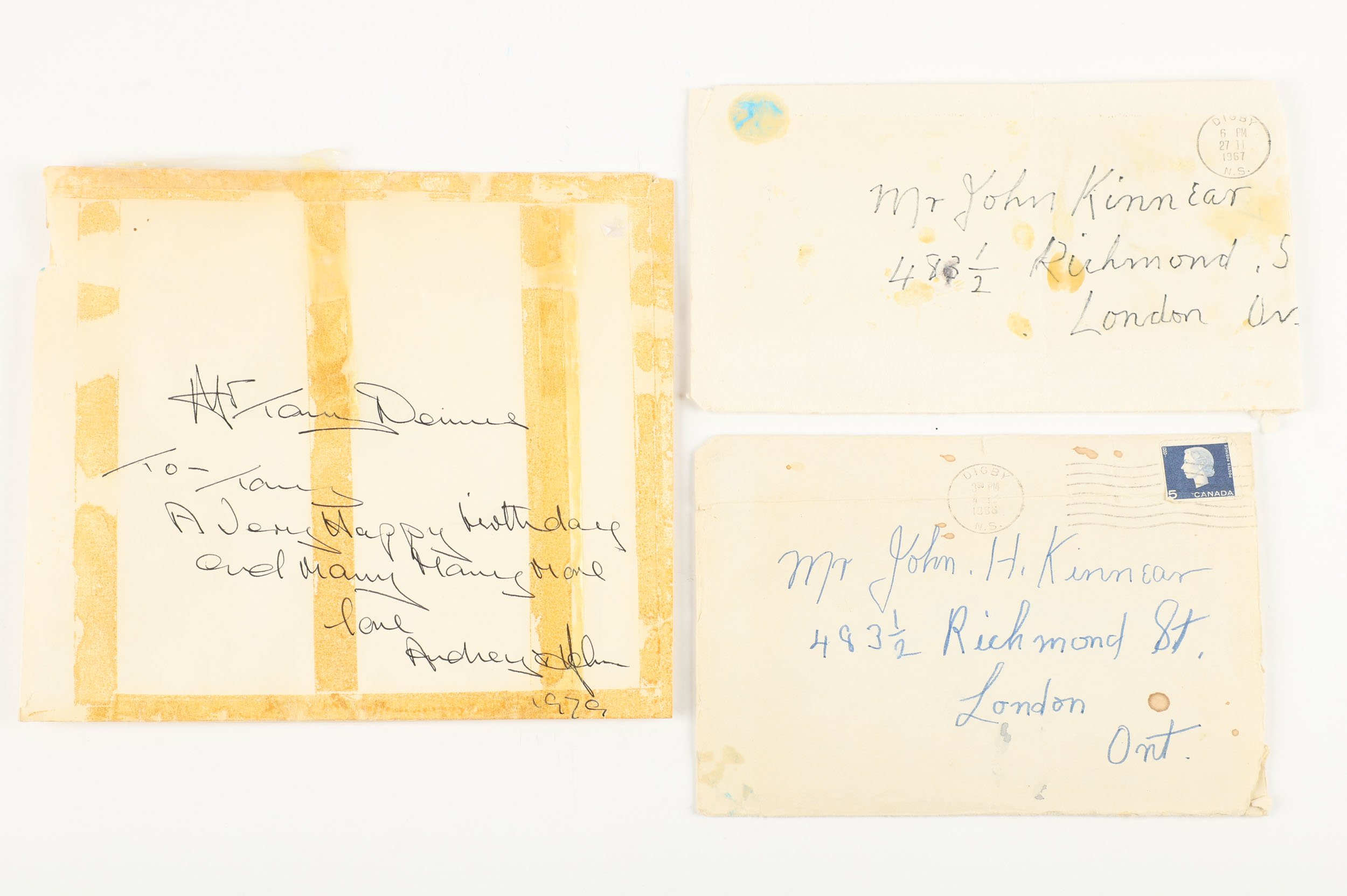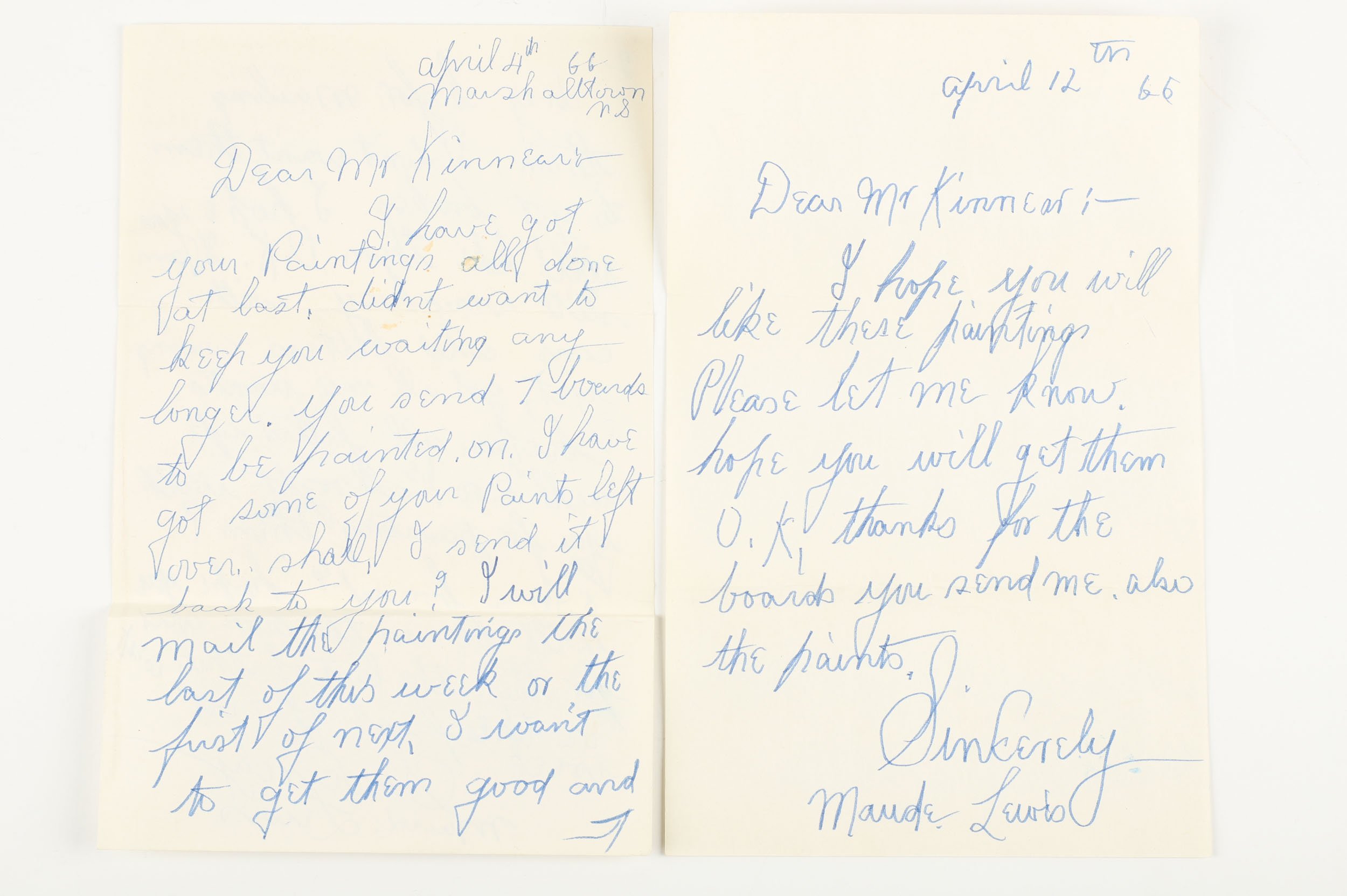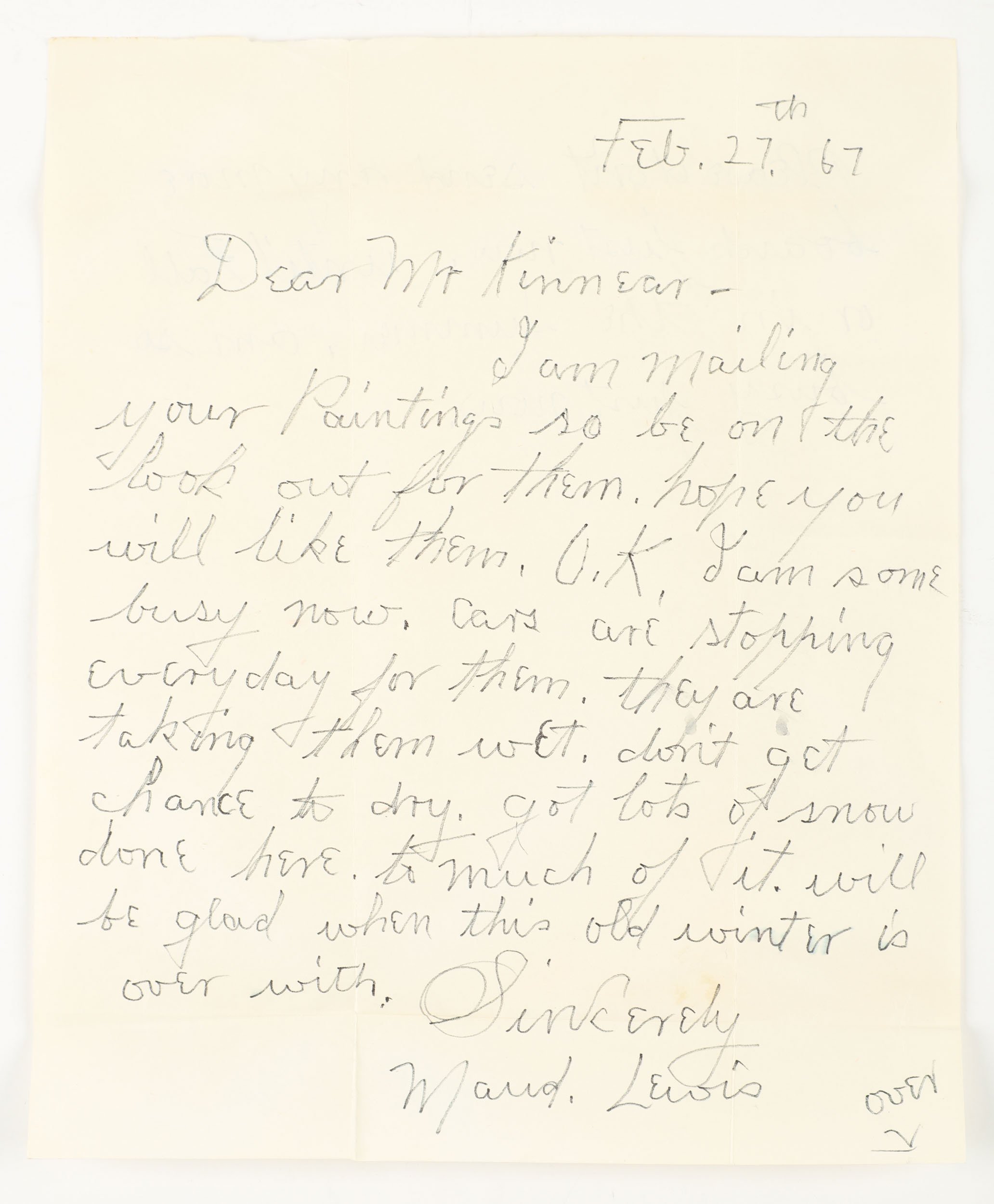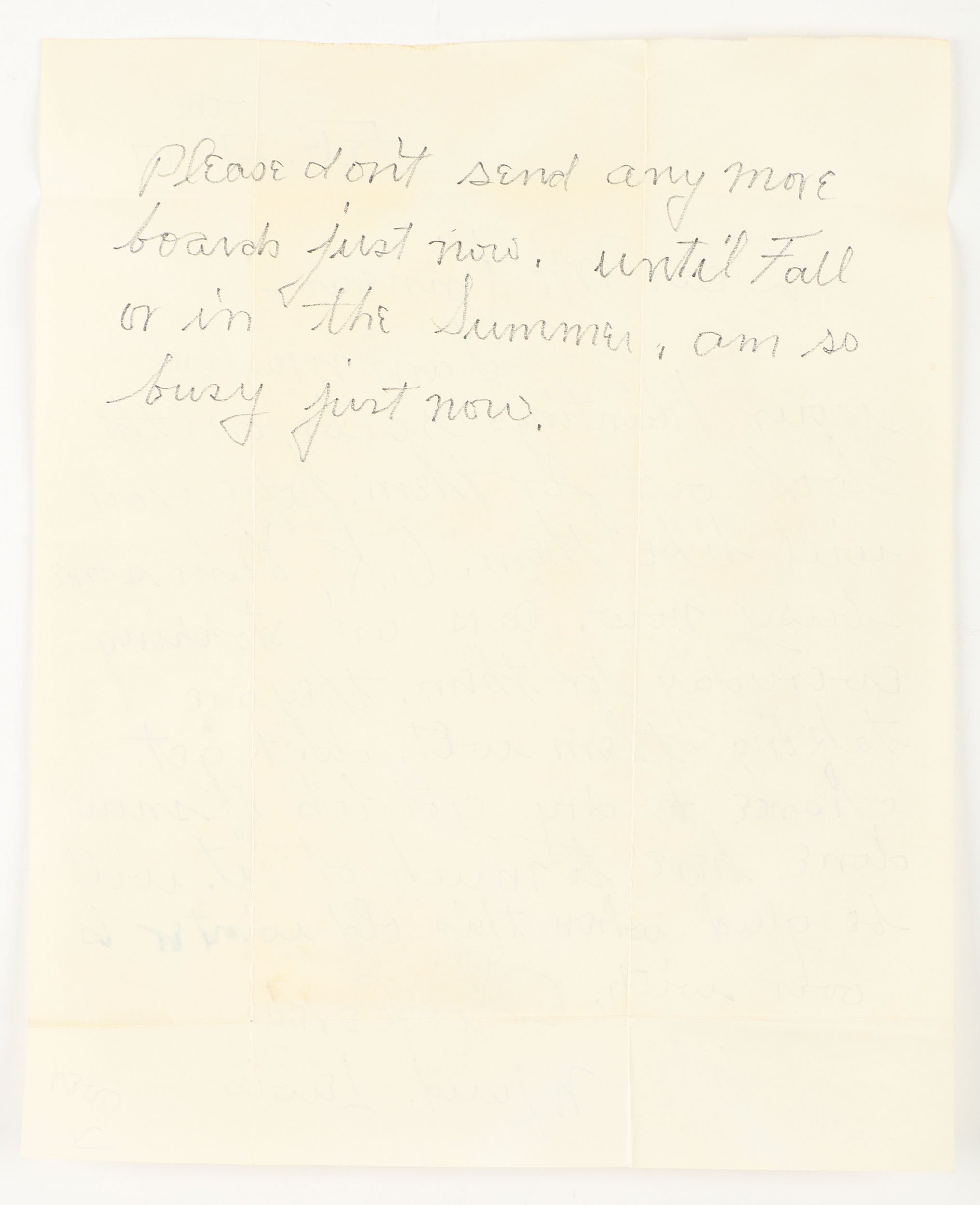Maud Lewis painting brings $350,000
Once traded for grilled cheese
Irene and Tony Demas pose with their rare Maud Lewis painting which sold for $350,000 at Miller & Miller Auctions on May 14.
It was an astounding and history-making moment at Miller & Miller’s May 14th Canadiana & Decorative Arts auction when the hammer finally came down at CA$350,000 for a rare Maud Lewis painting, originally estimated to sell for CA$30,000 to $35,000. Selling at 10 times the high estimate, with buyer’s premium the final price tag was CA$413,000.
The sale and the story that goes with it have generated widespread media attention, especially since the previous record for a painting by the late Nova Scotia folk artist was CA$67,250.
Almost as surprising was the sale of three hand-written letters by Maud Lewis, which were estimated to bring CA$3,500 to $5,000 but sold for CA$70,000, or $82,600 with buyer’s premium. Both lots went to Canadian buyers.
“The astonishing prices realized for both the Black Truck painting and Maud’s personal letters were no accident,” says Ethan Miller, CEO and co-owner of Miller & Miller Auctions. “Together they told a story that captured international interest and sent bidding into oblivion.”
“Everybody will look at their Maud Lewis paintings differently after this auction.”
The rare Black Truck painting was offered as lot 337 in the auction.
Adding to the incredulity of the story is the fact the painting was swapped five decades ago for a few grilled cheese lunches.
"Everybody will look at their Maud Lewis paintings differently after this auction," said an elated Irene Demas, who along with her husband Tony consigned the 11 by 14-inch Black Truck painting and the accompanying letters.
How retired restaurateurs Irene and Tony Demas came to own the Maud Lewis painting and her letters is the stuff of legends. Except the story is true.
Maud Lewis has been called one of Canada’s greatest folk artists, our own Grandma Moses. The late self-taught artist (1903-1970), suffered from multiple physical challenges, including hands that became increasingly stiff and gnarled with rheumatoid arthritis. In her lifetime, she never sold anything for more than $10.
As word of her paintings spread over the years so did the demand for them. No doubt she’d be shocked at their current values, which have exploded in recent years – but nowhere close to the results of the May 14th Miller & Miller sale. In 2021, two of her paintings sold at auction in the U.K. for more than a combined CA$100,000 (with buyer’s premium).
“The painting is the real deal,” confirms Alan Deacon, a Nova Scotia resident and arguably Canada’s foremost expert on Maud Lewis. He’s been studying her life and work for 54 years and personally met her several times. Lewis is what he calls a “serial image artist,” meaning she painted the same subject matter again and again. But the painting owned by the Demas’, featuring the little black truck, was not a common subject for the artist, who seemed to prefer oxen, cats and happy local landscapes. Deacon says Lewis only painted the black truck during the last five years of her life. “And that’s what makes it quite rare,” he says. “Her paintings have gone up hugely and the fact that this one is painted on Masonite also means it’s a more stable surface.”
Here’s how the story unfolded.
In the 1970s, the Demas’ owned and operated The Villa restaurant on Richmond Road in London, Ontario. One of their regular customers was the late John Kinnear, an English painter who came to Canada after serving in the Second World War and settled in London. Kinnear and his wife came into the restaurant every day, always sitting at the same table in the front window. He never ordered anything except grilled cheese sandwiches, according to Irene who was the chef. Over time, the Kinnears and the Demas’ became friends.
“Maud Lewis was painting on scraps of paper with leftover marine paint scavenged by her husband. ”
Back in the mid-1960s, John Kinnear had struck up a friendship with the then-little-known Maud Lewis after reading an article about her in the popular Star Weekly. He was deeply moved by her extreme physical challenges and abject poverty and admired the beauty and simplicity of her paintings. He felt sorry for her so mailed her a box of paints, sable brushes and primed standard Masonite boards. Lewis and her husband Everett lived in Marshalltown, N.S. in a tiny, one-room house with no electricity or running water. At the time, she was painting on whatever she could find – particle board, cardboard, scraps of wallpaper and shells. She used simple house paint, or leftover marine paint scavenged by her husband from Acadian fishermen, saving empty soup cans for turpentine and sardine tins for paint.
When Kinnear sent her a second box of supplies, Lewis wrote back insisting on repaying him with some of her paintings. She’d send two or three at a time, sometimes five. Some of the paintings he sold in the London area for $24 each, sending a portion of the proceeds back to Maud and using the remainder to buy her more paint. Deacon says it’s likely that John Kinnear was the only artist ever to correspond with Maud Lewis.
One day during Kinnear’s regular visit to The Villa restaurant, he told Irene and Tony he had a number of paintings by a Nova Scotia artist and wondered if they might consider swapping a few grilled cheese lunches for one of them. They agreed to have a look.
“I was 21 at the time and my husband and I are both Europeans interested in antiques, so when we saw the paintings we were shocked – and more than a little reluctant,” recalls Irene. “I had never seen anything like them. They were so childlike, with cats and cows, and one featured this little black truck. I remember John telling us how Maud was this crippled up little bird-like lady and how sorry he felt for her.” The Demas’ ended up agreeing to the trade, choosing the truck painting. Irene was pregnant at the time so the truck seemed to them apropos, especially for a baby boy, which is what they had. There’s no way to know with certainty that the driver of the truck in the painting is Lewis’s husband Everett, “but that’s the suspicion,” says Deacon.
“Cars are stopping everyday for them. They are taking them wet.”
Several years after the painting-grilled cheese deal, Kinnear drew a charcoal bust of Tony Demas and gave it to him as a gift on his New Year’s Eve birthday. He also gave him three of the letters he’d received from Maud Lewis during their correspondence. In one of those letters (which was sold in the auction), she talks about the brisk business that had developed outside their tiny home where she was selling her paintings. “Cars are stopping everyday for them,” she writes. “They are taking them wet.”





Included in the sale were three letters from Maud Lewis to John H. Kinnear dated 1966 to 1967. They sold for $70,000. Click the arrows above to read each letter.
A 1965 CBC television piece about Maud Lewis also helped publicize her life and works while she was still alive, and the award-winning 2016 movie, Maudie, starring Sally Hawkins and Ethan Hawke, as well as The McMichael Canadian Art Collection’s 2019 travelling exhibition of the artist’s work, dramatically raised her profile posthumously while also contributing to growing international interest. “There is a large and diverse lot of Maud Lewis collectors out there now,” notes Deacon.
Vacationing Americans driving through Nova Scotia were regular customers of Lewis’s over the years and two of her paintings were bought by former U.S. president Richard Nixon’s administration.
Deacon recalls one of several visits he paid to Lewis. It was in the winter and she’d had a lot of time to paint without tourists around. She had 10 paintings finished and when Deacon asked if he could buy a blacksmith scene she’d done, he remembers her saying, “Oh no, you can’t have that one. It’s for a doctor in Digby.”
With such strong and growing interest in Maud Lewis’s work, the Demas’ decided it was time to sell. They’re long retired and are now considering both downsizing and travelling more. But it was a recent scare that really spurred them into action. After having non-glare glass added to the painting, the strip mall where the framer was located burned to the ground just days after they picked up their then-uninsured painting.
“We’d been approached a number of times over the years to sell it,” says Irene. “We saw that Miller & Miller had sold one not long ago and so we decided to meet with Ethan Miller. I liked him right away and I trusted him. We had a lot of questions and a lot of hesitation, but they were never pushy. We had a good feeling about the Miller brothers.”
Little did they know what was coming.
Deacon says there are few letters written by the artist known to still exist and the ones sold at the auction are exciting, he says, because they’re connected to John Kinnear and the story about his relationship with Maud Lewis.
Kinnear’s daughter, Sheila Kinnear, wrote a piece for the now defunct quarterly magazine Canadian Art, which was updated and reproduced in Reader’s Digest in March 2021. She describes how she, as a 12-year-old, was taught how to prime the Masonite boards her father sent to Maud. She also recalls his compassion for the artist. “When he learned of Lewis’s passing,” she writes, “he was filled with melancholy. ‘Maud was a beautiful woman, with a beautiful soul, and she painted from her heart,’ I remember him saying.”
By Diane Sewell
Diane Sewell has been a writer for over 25 years, producing feature stories for some of the country’s top newspapers and consumer magazines, as well as client newsletters and commissioned books.
Auction Details:
Canadiana & Decorative Arts
May 14, 2022
Did you enjoy this story? Feel free to share it using the links below:




